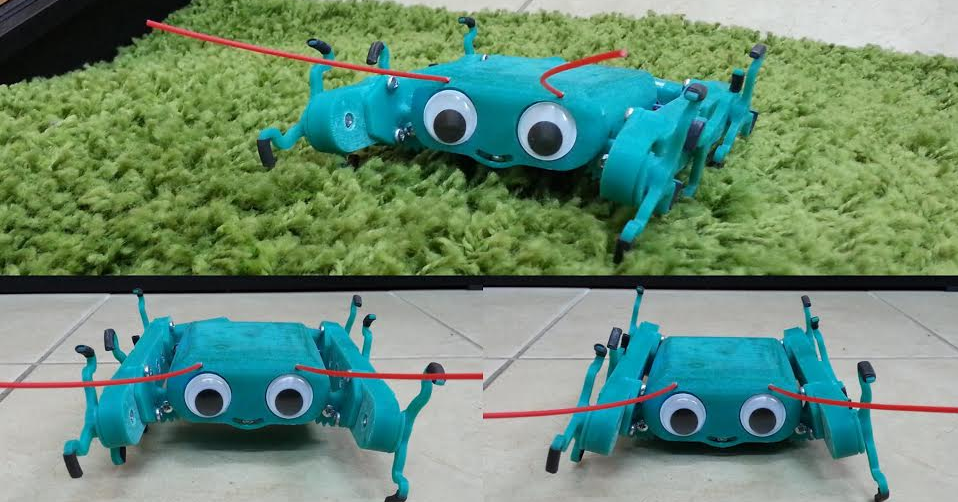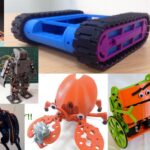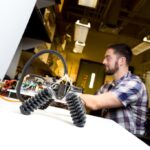

Robotics and 3D printing seem to be on a path of convergence. This can be seen in two different ways. On one hand, 3D printers are being used to customize and construct robots. On the other hand, robotics will eventually play a role in the development of more sophisticated 3D printers and perhaps even production facilities of numerous printers, all managed by robots.
If you recall, back in September 3DPrint.com covered a story about a Hexapod Robot named Billy. Billy was the creation of an Israeli engineer and PhD student named Jonathan Spitz. Spitz created Billy at the Faculty of Mechanical Engineering at the Technion, Israel’s Institute of Technology.
Billy, although he was a sight to be seen (check him out in the image to the right), still was not perfect according to Spitz. As Billy was Spitz’s first real 3D printed robotic creation, he thought he could perhaps do even better, by creating a sleeker, faster, and more versatile robotic insect.
“Following the success that I had with creating Billy, the blue beetle, with 3D printing, I decided to take what I learned and create an improved version of the robot,” explained Spitz to 3DPrint.com. “That’s how Charlie the cricket was born.”
If Billy is a minivan, then Charlie would be the sports car. Charlie’s vital organs include four micro DC motors, of which two are used for walking, while the other two are meant for sprawling. Charlie’s brain consists of an Arduino Micro, which receives command signals from his central nervous system, represented by a Bluetooth module. These command signals are then relayed to the Pololu Baby Orangutan controllers which drive the motors. By using this setup Spitz was able to free up the Arduino to take care of processing data, letting the Baby Orangutans manage the closed loop motor control.

As for the design improvements of Charlie versus Spitz’s original robot Billy, he explains:
“All of Charlie’s gears are now encased in a single housing with an easy to remove lid. This provides quick access to the gears and legs for swapping and at the same time protects the gears from dust, pebbles or other stuff that might get picked up on the way. Sprawling (rotating the legs sideways) allows him to use two locomotion modes: a fast mode for flat terrain and a slower mode for clearing obstacles. I built an obstacle course in my office, which Charlie cleared without problems. He can climb slopes of over 45 degrees and clear obstacles almost as tall as himself! Also, since he’s much slimmer than Billy, he can walk upside down, in case he falls over.
Charlie was 3D printed on an UP2 machine from Easy3D using only ABS material. The design and contruction of this robot took Spitz about three months, as he had to figure out just how to fit all the components into such a tight space. When it came time to print the robot out, it only took him two attempts to get the parts just right. The entire robot was printed out in approximately 24 hours, which falls slightly under the time it took to print out Charlie’s brother, Billy.
Spitz is now turning his attention to a possible business model for his creations.
“Now that my robot building skills are more mature, I’m looking for the best way to bring these cute robots to market,” Spitz told us. “I’m working on some games that you can play with a single Charlie or many robots, and then I’ll prepare the whole idea for crowdfunding. 3D printing will definitely be involved but I’d rather keep those plans secret for now.”
We will be watching closely for Spitz’s next move, as his plans seem rather interesting. Stay tuned for updates regarding his possible crowdfunding campaign. Let’s hear your thoughts on Charlie in the 3D Printed Robotic Insect forum thread on 3DPB.com. Check out Charlie in action in the video below:
When it comes to 3D real estate visualization in the USA, our service provides the perfect solution for bringing property listings to life. Through our platform, you can easily access cutting-edge 3D renderings that showcase your real estate projects in a way that attracts potential buyers and investors. Whether it's residential, commercial, or mixed-use properties, our team of experts uses advanced technology to create immersive visualizations that highlight the best features of your property, making it easier for clients to imagine the space as their own.
Through our website, you can quickly get high-quality 3D real estate visualizations that are tailored to your specific needs. With our help, you'll stand out in the competitive real estate market by offering potential buyers a realistic, interactive view of your property. Our efficient process ensures a fast turnaround time, while our attention to detail guarantees that every aspect of the property is represented accurately, giving you a powerful marketing tool to promote your real estate listings.






